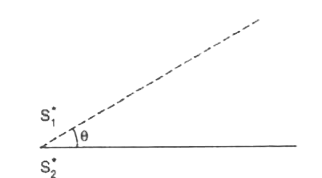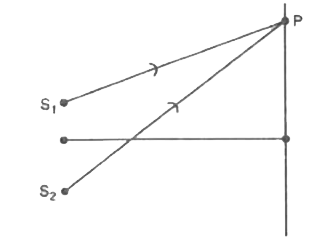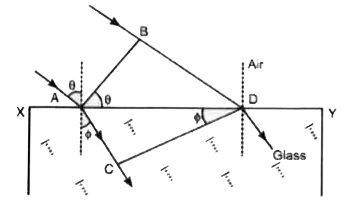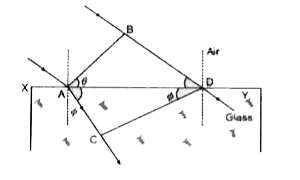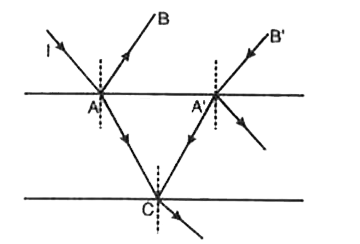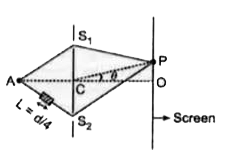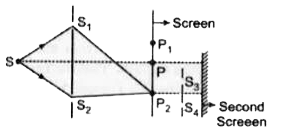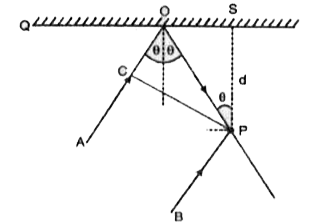MCQ LEVEL -1 from MODERN PUBLICATION PHYSICS (KANNADA ENGLISH) WAVE OPTICS for Class 12
| Class 12 | PHYSICS |
| Chapter | WAVE OPTICS |
| MODERN PUBLICATION PHYSICS (KANNADA ENGLISH) | MCQ LEVEL -1 |
| Medium | English |
| Academic Year | 2023-2024 |
Question 3
In the figure given below, P and Q are two equally intense coherent sources emitting radiations of wavelength 20 m. The separation between P and Q is 5.0 metre and phase of P is ahead of the phase of Q by 90∘, A, B and C are three distant points of observation, equidistant from the mid point of PQ.The intensity of radiation at A, B, and C will bear the ratio :
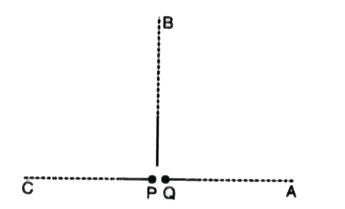 View Solution
View SolutionQuestion 6
In Young's double slit experiment the light emitted from source has λ=6.5×10−7 m and the distance between the two slits is 1 mm. Distance between the screen and slit is 1 metre. Distance between the screen and slit is 1 metre. Distance between third dark and fifth bright fringes will be : View SolutionQuestion 9
White light is used to illuminate the two slits in Young's double slit experiment, separation between the slits is b and the screen is at a distance d(>>b) from the slits.At a point on the screen, directly in front of the slits, certain wavelengths are missing.Some of these missing wave lengths are : View SolutionQuestion 14
A plane monochromic light falls normally on a diaphragm with two narrow slits separated by a distance d = 2.5mm. A fringe pattern is formed on the screen placed at D = 100 cm behind the diaphragm.If one of the slits is covered by a glass plate of thickness 10μm, then distance by which these fringes will be shifted is :View SolutionQuestion 15
In a two slit experiment with monochromatic light, fringes are obtained on a screen placed at some distance from the slits.If screen is moved by 5×10−2 m towards the slits, then change in fringe width is 3×10−5 m. If the distance between slits is 10−3 m, then wavelength of the light used will be :View SolutionQuestion 37
A parallel monochromatic beam of light is incident normally on a narrow slit. A diffraction pattern is formed on a screen placed perpendicular to the direction to the incident beam. At the first minimum of the diffraction pattern, the phase difference between the rays coming from the two edges of slit is : View SolutionQuestion 43
A source emits electromagnetic waves of wavelength 3 m. One bema reaches the observer directly and other after reflection from a water surface, travelling 1.5 m extra distance and with intensity reduce to (14) as compared to intensity due to direct bema alone. The resultant intensity will be :View SolutionQuestion 49
In Young's double slit experiment dD=10−4 (d = distance between slits, D = distance of screen from the slits) At a point P on the screen the resulting intensity is equal to the intensity due to individual slit I0.Then the distance of point P from the central maximum is (λ=6000Å) :View SolutionQuestion 52
Statement I : In a young's double slit experiment two slits are at distance d part.Interference pattern is observed on a screen at distance D from the slits. At a point on screen directly opposite to one of the slits, a dark fringe is observed.The wave length of wave is d2D.
Statement II : If the entire double slit experiment is dipped in water, the fringe size gets reduced.View SolutionQuestion 57
Questions 57 and 58 are based on following paragraph : A glass plate 12×10−4 mm. Thick is placed in the path of one of the interfering beams in a biprism experiment using wavelength 600Å
57. The central band shifts a distance equal to width of the band, then refractive index of glass plate isView SolutionQuestion 59
Questions 59 and 60 are based on following paragraph : A beam of light consisting of two wavelengths 6500Å and 5200Å is used to get interference fringes in Young's double slit experiment with slit distance 2 mm and screen distance 120 cm.
59. The distance of 3rd fringe on screen from central maxima for wavelength 6500Å isView SolutionQuestion 67
In a Young's double slit experiment, the slits separated by 1 mm are illuminated by a mixture of two wavelengths λ=600nm and λ'=750nm.The distance of screen from slits is 1 m. The minimum distance from the common central bright fringe where the bright fringe of one interfernece pattern will coincide with the bright fringe of second interference pattern will be :View SolutionQuestion 68
In a two slit experiment with monochromatic light, fringes are obtained on a screen placed at some distance from the slits.If screen is moved by 5×10−2 m towards the slits, then change in fringe width is 3×10−5 m. If the distance between the slits is 10−3 m, calculate the wave length of light used.View SolutionQuestion 84
The figure shows a surface XY separating two transparent media, medium - 1 and medium - 2.The lines ab and cd represent wavefronts of a light wave travelling in medium -1 and incident on XY. Then lines ef and gh represent wavefronts of the light wave in medium- medium after refraction.
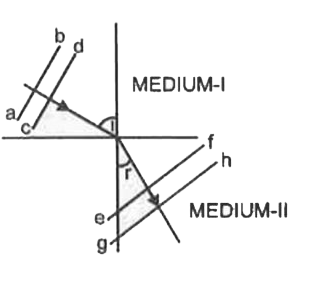
84. Light travels as aView SolutionQuestion 86
Questions number 86-88 are based on the following paragraph :
An initialy parallel cylindircal beam travels in a medium of refractive index μ(I)=μ0+μ2I, where μ0 and μ(2) are positive constant and I is the intensity of the light beam.The intensity of the bema is decreasing with increasing radius.
86. The initial shape of the wavefront of the beam is:View SolutionQuestion 91
In a Young's double slit experiment the fringes are displaced by a distance x when a glass plate of refractive index 1.5 is introduced in the path of one of the bemas.When this plate is replaced by another plate of the same thickness, the shift of fringes is 32x.The refractive index of the second plate is :View SolutionQuestion 99
A spectral line of wavelength 0.59 mm is observed in the directions to the opposite edges of the solar disc along its equator.A difference in wavelength equal to (Δλ), 8 picometre is observed.Period of sun's revolution around its own axis will be about (Radius of sun = 6.95×108m)View SolutionQuestion 100
In Young's double slit experiemnt using monochromatic light, fringe pattern shifts by a certain distance on the screen when a mica sheet of refractive index 1.6 and thickness 1.964 mm is introduced in the path of one of the twao waves.If now mica sheet is removed and distance between slit and screen is doubled, distance between successive max. or min. remains unchanged.The wavelength of the monochromatic light used in the experiment is :View SolutionQuestion 101
In a Y oung's double slit experiment, separation between the slits is 2×10−3 m and distance of the screen from the slit is 2.5 m. Light in the range of 2000 - 8000 Å is allowed to fall on the slits.Wvelength in the visible region that will be present on the screen at 10−3 m from the central maxima will be :View SolutionQuestion 103
In a biprism experiment, the eye piece was palced at a distance of 20 cm from the source.The distance between two virtual sources was found to be 0.075 cm. Find the wavelength of source of light if the eye piece ahs to be moved through a distance of 1.888 cm for 20 fringes to cross the field of view :View SolutionQuestion 105
In Young's double slit experiment, the two slits act as coherent sources of equal amplitude A and of wavelength λ.In another experiment with same set up, the two slits are sources of equal amplitude A and wavelength λ, but are incoherent.The ratio of intensty of light at the mid - point of the screen in the first case to that in the second case is :View SolutionQuestion 109
In a double slit experiment using monochromatic light, the fringe patern shifts by a certain distance on the screen when a mica sheet of μ=1.6 and thickness t=1.964μm is introduced in the path of the one of the interfering waves.The mica sheet is then removed and the distance between the slits and the screen is doubled.It is found that the distance between successive max. or min. is now the same as the observed fringe shift upon introducing of the mica sheet. Calculate the wavelength of light used in experiement:View SolutionQuestion 119
Light from a source emitting two wavelengths λ1 and λ2 is made tyo fall on Young's double slit appratus after filtering one of the wavelengths.The position of interference pattern is noted.When filter is removed, both the wavelength are incident.It is found that maximum intentsity is produced where the fourth maxima occured intially. If the other wvaelength is filtered, at the same location, the third maxima is found. What is the ratio of wavelengths?View SolutionQuestion 120
Two light rays having the same wavelength λ in vacuum are in phase initially. Then the first ray travels a path L1 through a medium of refractive index n1 while the second ray travels a path of length L2 through a medium of refractive index n2. The two waves are then combined to observe interference. The phase difference between the two waves is :View SolutionQuestion 122
Statement I : If phase difference between the light waves emerging from slits of Young's experiment is π radian, then central fringe will be dark.
Statement II : Light from two coherent sources is reaching screen. If path difference at a point on the screen for the yellow light is 3λ2, then the fringe at that point is coloured, bright.View SolutionQuestion 124
Questions 124 and 125 are based on paragraph given below: Unpolarised light of intensity 32 W m−2 passes through three polarisers such that transmission axis of last polariser is crossed with first, the intensity of emergent light is 3 Wm−2.
124. The nagle between transmission axis of first two polarisers isView SolutionQuestion 127
Light passes successively through two polarimeter tubes each of length 0.29m. The first tube contains dextrorotatory solution of concentration 60 kg m−3 and specific rotation 0.01 rad m2kg−1. The second tube contains laevo-rotatory solution of concentration 30 kg m−3 and specific rotation 0.2 rad m2kg−1.The net rotation produced is :View SolutionQuestion 131
Figure shows a two slit arrangement with a source which emits unpolarised light P is a polariser with axis whose direction is not given. If I0 is the intensity of the principal maxima when no polariser is present then the intensity of the principal maxima as well as of the first minima are
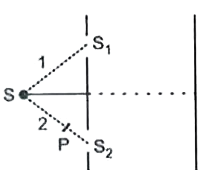 View Solution
View SolutionQuestion 148
A mixture of light, consisting of wavelength 590 nm and unknown wavelength, illuminates Young's double slit and gives rise to two overlapping interference patterns on the screen.The central maximum of both lights coincide.Futther, it is observed that the third bright fringe of known light coincides with the 4th bright firnge of the unknown light.From this data, the wavelength of the unknown light is :View SolutionQuestion 152
The question has a paragraph followed by two statements, Statement - 1 and Sstatement - 2. Of the given four alternatives after the statements, choose the one that describes the statements.
A thin air film is formed by putting the convex surface of a plane - convex lens over a planeglass plate. With monochromatic light, this film gives an interference pattern due to light reflected from the top (convex) surface and the bottom (glass plate) surface of the film.
Statement - 1: When light reflects from the air - glass plate interface, the reflected wave suffers a phase changing of π.
Statement - 2 : The centre of the interference pattern is dark.View SolutionQuestion 154
In a Young's double slit experiment, two slits act as cherent sources of waves of equal amplitude A and wavelength λ. In another experiment with the same arrangement the two slits are made to act as incoherent sources of waves of same amplitude and wvaelenght. If the intensity at the middle point of the screen in the first case is I1 and in the second case is I2 then the ratio I1I2 is : View SolutionQuestion 155
Statement -1 : On viewing the clear blue portion of the sky through a calcite crystal, the intensity of transmitted light varies as the crystal is rotated.
Statement -2 : The light coming from the sky is polarized due to scattering of sunlight by particles in the atmosphere.The scattering is largest for blue light.View SolutionQuestion 160
Two beams, A and B, of plane polarized light with mutually perpendicular planes of polarization are seen through a polaroid. From the position when the beam A has maximum intensity (and beam B has zero intensity), a rotation of Polaroid through 30∘ makes the two beams appear equally bright.If the initial intensities of the two beams are IA and IB respectively, then IAIB equals :View Solution
 .
.